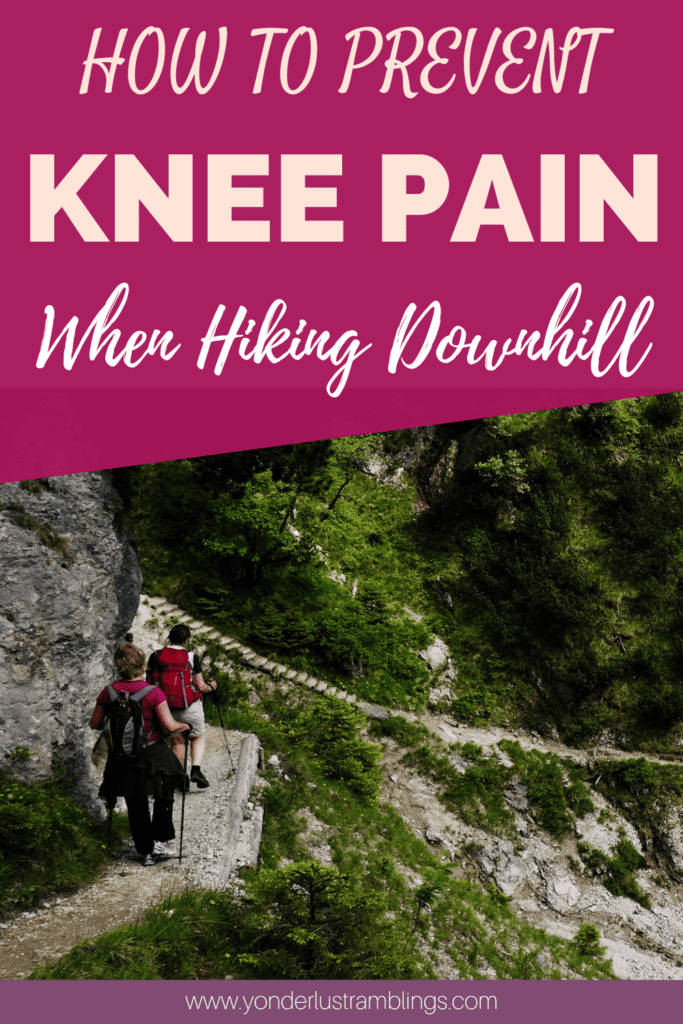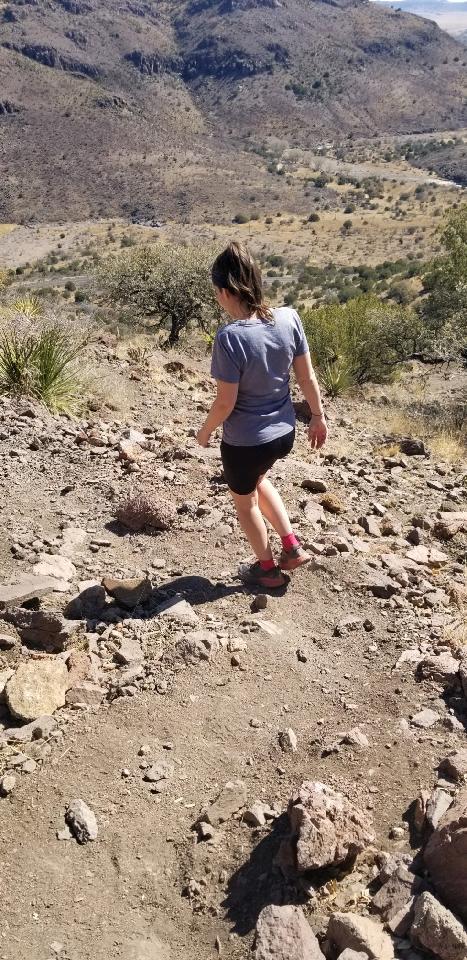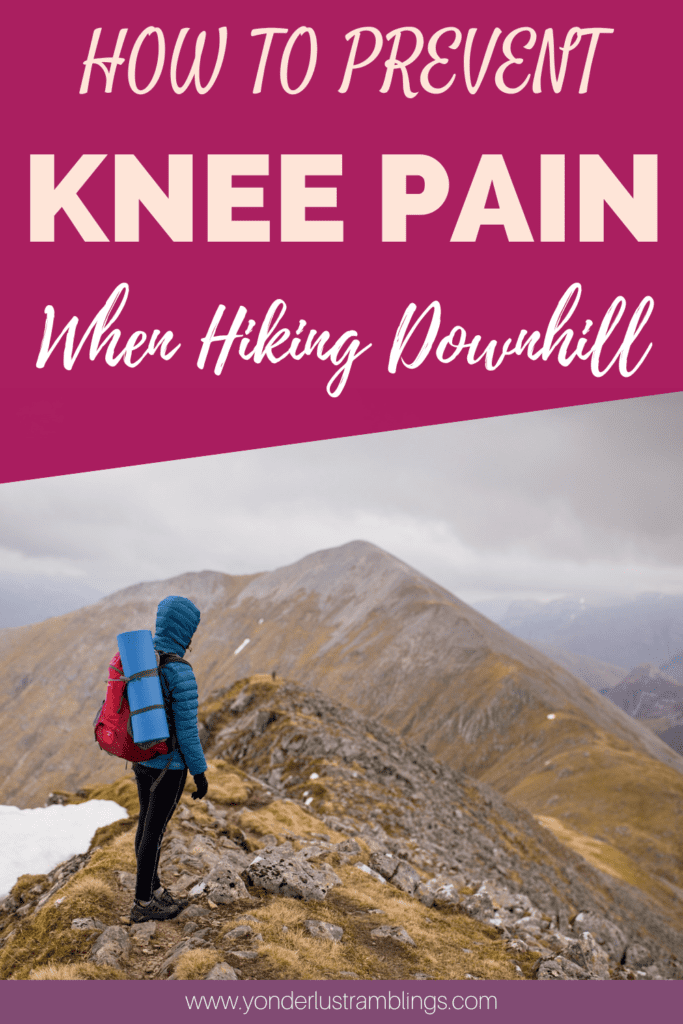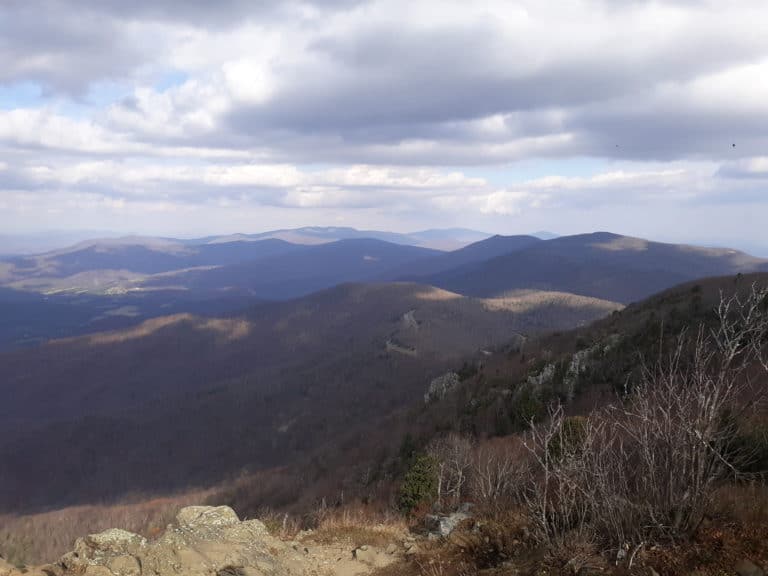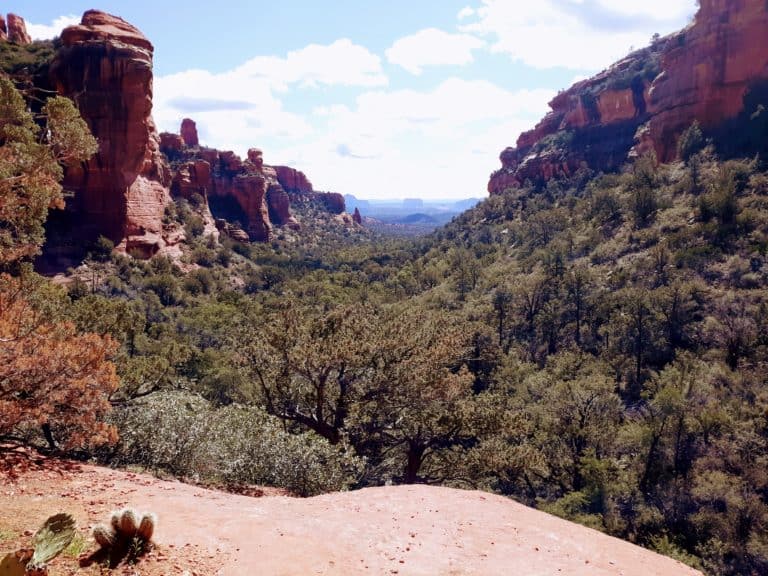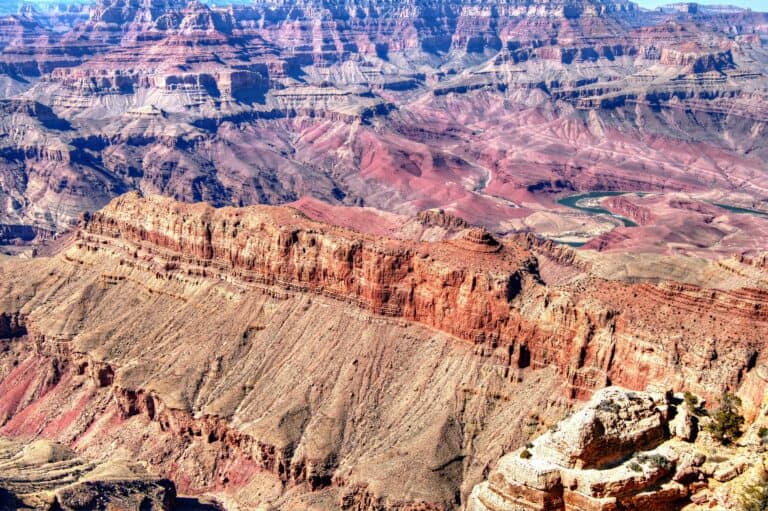What Causes Knee Pain Hiking Downhill, and How to Prevent It
It is easy to see why hiking brings so much joy to many, and it is easy to list the many benefits of hiking. However, many hikers deal with the recurring issue of knee pain hiking downhill, and it sure can put a damper on the hiking experience. If you are someone that suffers from knee pain when hiking downhill, you may be asking yourself what causes it, and what can you do to prevent it? This guide will address both those questions, and provide some helpful and proactive strategies for dealing with knee pain when hiking downhill.
Disclosure: Below are some affiliate links-these are all products I highly recommend. I won’t make any recommendations on this page that I haven’t tested or personally used!
Understanding Knee Pain Hiking Downhill
So why exactly do you experience knee pain when hiking downhill, but not so much on uphill or flat terrain? Mostly this is due to the fact that your knee is under significantly more pressure when hiking downhill, than on uphill or flat surfaces. When you hike downhill, that leading knee is pulling double duty of absorbing the downhill forces and the impact of bodyweight.
Hiking downhill is a one leg at a time sort of ordeal. Your leading leg in front is bearing the full impact of your body, plus the additional forces of going downhill, plus the additional weight of whatever you might be carrying (like a fully loaded backpack). In fact, studies have shown that the force on your knees can be up to 8 times your bodyweight when hiking downhill versus regular hiking on a flat surface.
Who is Most Prone to Experience Knee Pain When Hiking Downhill?
Knee pain can happen to a newbie or novice hiker. Not every hiker will experience knee pain when hiking downhill, but there are some common signs to watch for. You may be more at risk if you have:
- A prior injury
- Weak or imbalanced leg muscles
- Trouble with shoes/fit
- Lots of long, extended hikes
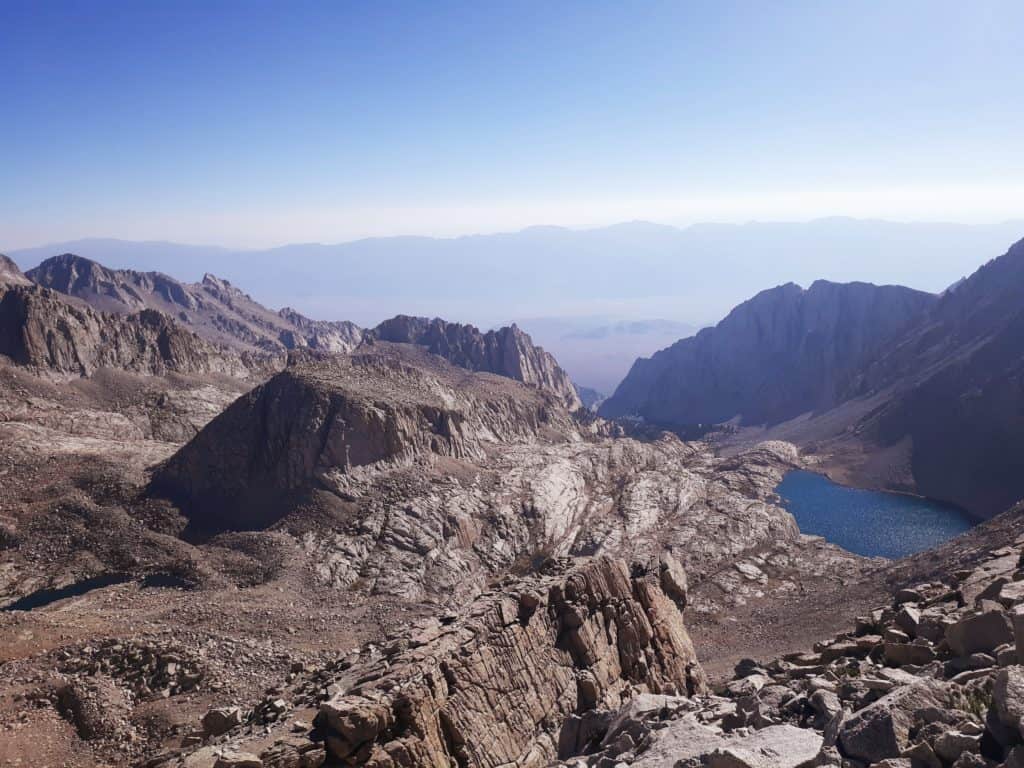
What Causes Knee Pain When Hiking Downhill?
This is not an exhaustive list, but these are some common culprits of knee pain that is experienced when hiking downhill.
- Added pressure/force
- Added Weight
- Hyperextending (over lengthening) the knee
- Imbalanced leg muscles – shin pain in one leg causing you to favor the other, an old injury to one knee, etc.
- Weak leg muscles – if your leg muscles aren’t functioning at full strength, it may be causing over-reliance on your knees
- Weak or tight hips – if your hips aren’t functioning at full capacity, it may cause your knees to be picking up the slack
- The Wrong Shoes – compressive pressure is a BIG cause of knee pain when hiking downhill. Make sure you are wearing the right shoe with the right fit, a hiking shoe or trail runner with plenty of cushioning to combat compressive pressure, and make sure you are NOT wearing an overly old shoe lacking cushioning
- Inadequate total body conditioning – hiking is a full body workout, which is why total body conditioning and full body strengthening is vital to a healthy hike, one in which your knees aren’t trying to pick up the slack for the rest of your muscles not functioning in harmony together! Engage in full body conditioning and strength training with exercises like yoga, Pilates, cycling, walking, jogging, etc.
- Medical Conditions – there are some medical conditions that can cause knee pain, that should be ruled out and/or addressed by a medical professional if they are ongoing. Some of these potential medical conditions include:
-
- Bursitis – the bursa is a small sac of fluid under the skin and above the knee joint. Falls and overuse can irritate the bursa and lead to pain and swelling.
- Dislocated kneecap
- Inflamed IT band – the IT band is a tissue that runs from your hip to your knee. Conditions like overuse can cause it to become inflamed.
- Cartilage tears
- Osteoarthritis
- Tendinitis – tears in the tendon
-
How to Prevent Knee Pain When Hiking Downhill
There are a lot of proactive ways you can prevent knee pain from happening!
- Start Slow – don’t go tackling a 14’er in Colorado as your first experience with downhill hiking. (If you ARE looking for a first 14’er to tackle, might I suggest Mt. Elbert – the perfect beginner 14’er!) Work up to that gradually by first hiking flat terrain, then hiking small hills downhill, then taking on some regular, short hikes with downhill portions, then tackling that big epic mountain hike with the massive downhill! In addition to the degree of downhill hiking, start slow with your hiking speed and distance before increasing those two factors as well.
- Strength Training and Full Body Conditioning – as mentioned above, hiking involves all the muscle groups of the body. Your knees will be happy to play their part, but they may complain if asked to shoulder more than their fair share, due to an underperformance of other vital muscles. Take part in regular full body strengthening and conditioning in order to prevent knee pain when hiking downhill. This can involve yoga, Pilates, cycling, jogging, weight lifting, HIIT (high intensity interval training) workouts, and leg strengthening exercises, as listed below.
***Download your own customizable HIIT Home Workout Plan HERE!
***If you are involved in a hiking training regimen for an upcoming long hike, like the Grand Canyon’s Rim to Rim hike, or Mt. Whitney’s 21 mile uphill and downhill trek, be sure to follow a personalized hiking training calendar, one that gradually increases, and also builds in cross training / strength training days, as well as rest days!
Check out my 16 week Rim to Rim Hiking Training Calendar HERE!
- Leg Strengthening Exercises – focus on your hamstrings, quadriceps, glutes, and calf muscles. Complete these leg strengthening exercises regularly:
-
-
- Squats – stand with feet hip width apart with toes facing front. Drive your hips back by bending at the knees and ankles, then lower into a squat position (imagine you are lowering into a chair) while keeping heels and toes on the ground, and chest and shoulders back.
-
- Lunges – alternate legs to do 90 degree leg lunges.
-
- Wall Sits – place your feet on the ground shoulder width apart, and a few feet out from the wall. Slide your back down the wall until you reach a 90 degree bend in your legs, while keeping your core engaged. Hold for 30 seconds.
-
- Step Ups – step up on a curb, stair, or exercise platform by alternating feet and keeping your knees and body straight as you lift your body up.
-
- Hip Raises – lie with your back on the floor, knees bent, and feet flat on the floor. Keep your hands out to your side palms flat, and raise your glutes off the floor by lifting your hips up and pushing down through the heels of your feet, until your back, hips, and thighs are in a straight line. Hold and repeat.
-
- Heel Drops – standing up straight, raise your heels off the floor to lift your body, transferring your weight to the balls of your feet. Hold, drop back to your heels, and repeat.
-
- Straight or Bent Leg Raises – lie on your back with hands at your sides. Keeping your legs straight or just slightly bent, lift your legs until your body forms an “L” shape. Hold, then lower both legs together slowly to the ground, and repeat.
-
- Single Leg Deadlifts (best with small weight or kettlebell) – stand with feet hip width apart. Lean forward with your hips, transferring your weight onto one leg, while the other leg begins to extend straight out behind you. Continue to lift the extended back leg and lean forward with your weight, while keeping a slight bend in your standing leg, until your body forms a “T” shape. Bring in extended back leg and repeat on other side.
-
- Jump Rope – grab your own jump rope here for this straightforward strengthening exercise.
-
- Hiking Poles – hiking poles are not necessary for every hike. And they are not necessary for every person. BUT, if you are someone that struggles in particular with knee pain when hiking downhill, there is a strong argument for using hiking poles to help shoulder the burden of that downhill compressive pressure and added weight, and also to help prevent overextension of the knee. In fact, medical studies have provided evidence that hiking poles can help mitigate knee pain when hiking downhill by taking some of the pressure off your knees and redistributing it. Get the most trusted pair of hiking poles with these Black Diamonds! I love this particular pair for their cork handles, which prevent slippage and blisters from sweaty palms, like some other rubber or plastic handled hiking poles.
- The Right Shoes – make sure you are hiking downhill in shoes that fit right and have superb cushioning. A solidly supportive shoe can make a world of difference for knee pain. If they are older shoes that are worn down, consider a new pair, and your knees will likely thank you! Personally, I hike the majority of my hikes in trail runners, because they leave my feet feeling more cushioned and “fresher” after really long day hikes. You cannot beat HOKA One One Speedgoat Trail Runners for their cushioning and traction. When I do feel the need for a traditional, waterproof hiking boot, these Vasque Breeze GTX III’s are my go to!
- Avoid Unnecessary Weight – it is important to always hike with the 10 essentials, but be sure to avoid hiking with unnecessary weight.
***Download your own Day Hiking Essentials Packing List HERE!
- Yoga / Pilates – yoga and Pilates are great for full body strengthening, conditioning,balancing, and stretching. Yoga and Pilates encourages all your body’s muscle groups to work together harmoniously, and your knees will benefit. It is also extremely beneficial in that it targets the ability to work on balancing, a great tool to have when you are hiking downhill and shifting weight between legs.
- Warm Up and Stretch Before – a quick warm up and stretch before hiking that involves downhill portions can proactively help your knees. It could be as simple as performing a few squats, lifting up on your toes, and rolling your ankles, before setting off.
- A Knee Brace – a knee brace is a great and relatively inexpensive way to help provide additional support to your knee when hiking downhill. However, if there is an ongoing or bigger issue behind your knee pain, a knee brace is not the final solution. Seek professional medical help to address the issue, as well as wearing a knee brace.
- Shorten Your Steps – be mindful of your steps when hiking downhill. Overextending the knee can be a main cause of knee pain when hiking downhill, so consider shortening your stride and hike with short steps. One way to gauge if your stride is ideal, is to make sure to keep your torso too far forwards or backwards. Keep your shoulders above your ribcage, and your ribcage above your hips. Keep your knees from going in front of your toes.
- Slow Down – take your time (which will also naturally help you with shortening your steps). Be mindful of foot placement, and give your knees a bit of a break.
- Avoid Downhills – if your knee pain is serious, but you don’t want to lose out on the joy of hiking completely, as a most extreme method of mitigating knee pain when hiking downhill, you can simply avoid trails with extended or significant downhill portions. Check out hiking apps like All Trails, which can give you elevation chart profiles, which will help you determine the amount of downhill hiking is involved in that particular trail. Below you can see the elevation differences between a hike with significant downhill, like California’s Mt. Whitney, versus White Sand National Park’s Alkali Flat Trail.


***It is important to note that if you are experiencing knee pain when hiking downhill, you can be proactive and utilize the above strategies, but you also need to do that in conjunction with professional medical help, especially if your knee pain is intense or continuing. A medical professional will be able to offer additional help, which may include recommendations for:
- Icing post hiking
- Elevating the knee
- Medications
- Physical Therapy
- Surgery
PIN for LATER!


